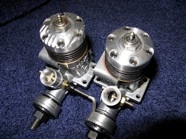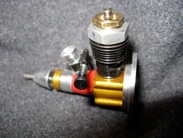Rework
Preliminary Coordination – In general it is best to notify me (email link) that you are sending an engine for work and provide some idea what you desire in terms of modification or repair. You might consider insuring the package if sent by the USPS. When the engine is received you will be notified by email. Prior to any modifications the engine will be run to provide a baseline for performance comparison. This pre-mod run presupposes that the engine is received in operable condition. Should repairs be required which preclude running the engine, the pre-mod run will not be performed. Also if the engine is excessively dirty or gummed-up it will not be run prior to modification. When selecting an engine to be reworked be aware that the old adage about making a silk purse out of a sow’s ear applies to making model airplane engines run fast. If your engine is “over-the-hill” you will be notified as to possible options.
Engine Rework - The engine will then be disassembled while recording various geometric parameters, such as port timing and piston/liner position at TDC, and the general condition of the parts. Any modifications or repairs and the charges will be coordinated with the owner prior to performing any work. Some of the more interesting internal conditions that needed to be corrected before any runs or rework could be performed are shown discussed on the Repair page. Links to pages which describe specific rework and complete rework packages are provided on the left margin of the pages.
Once it is mutually decided what work is to be performed the engine will be modified/repaired, ultrasonic cleaned, and reassembled noting critical set-up dimensions. A post-mod run or runs will be performed and performance compared to the as received performance. For nostalgia engines all runs will be performed using 15% nitro fuel with 25% oil (1/2 being castor) - use of higher nitro levels is left to the owner. More modern cross scavenged engines with ball bearing supported shafts and schnurle ported engines will be run on 25% nitro. Vintage FAI, 1/2 A, and 1/4 A engines will be run on fuel with appropriate nitro levels coordinated with the owner. Special props will be used for test runs if provided by the owner and coordinated prior to sending the engine for rework.
Before and after performance, modifications performed, prop, fuel used and key set-up parameters will be reported to the owner. The engine, along with any replaced parts, will be returned to the owner via insured USPS first class mail (unless UPS is specifically requested) with a bill. Where possible coordination will be by email.
For a short movie of a McCoy 29 ignition running on the test stand click on the run control in the movie frame below. Normally a scatter shield is in-place to retain and objects such as prop blades which might be shed by the engine.
Below is another movie showing a Nelson 40 in the test stand turning a full APC 10X4 prop about 19600 rpm. This time the scatter shield is in place for the entire run.

